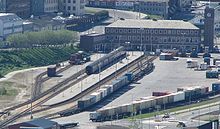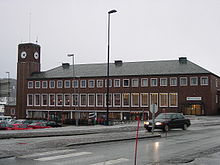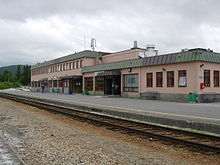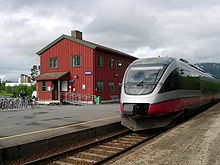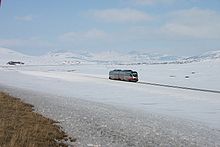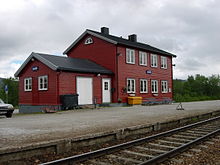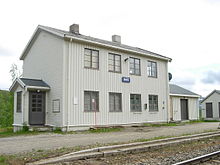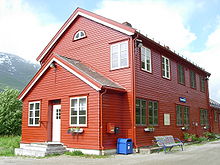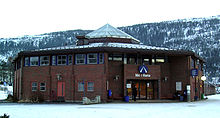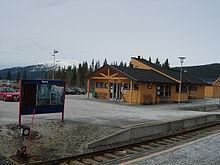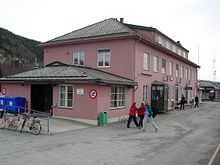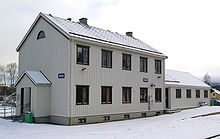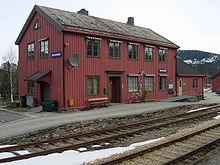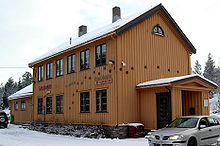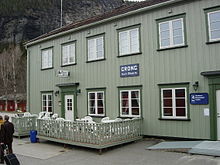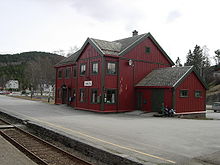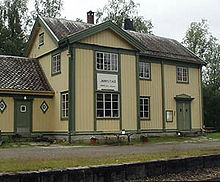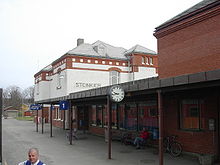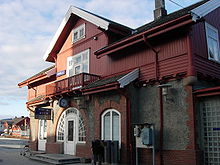- Nordland Line
-
Nordland Line 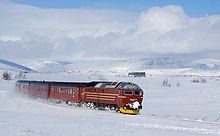
An NSB Di 4 unit on the Nordland Line at SaltfjelletOverview Type Railway System Norwegian railway Termini Trondheim Central Station
Bodø StationStations 43 Operation Opened 1882 (to Hell)
1962 (to Bodø)Owner Norwegian National Rail Administration Operator(s) Norges Statsbaner
CargoNet
CargolinkCharacter Long-haul passenger/freigh
Commuter trainsRolling stock Class92, Class 93, Di 4, CD66 Technical Line length 729 kilometres (453 mi) No. of tracks Single Track gauge 1,435 mm (4 ft 8 1⁄2 in) Electrification No Route map 
728.75 km Bodø (1961) 
branch line to Dreyfushammaren 
720.72 km Mørkved (1987) 
719.38 km Støver (1962) 
710.75 km Tverrlandet (1961) 
704.00 km Oteråga (1962) 
685.62 km Valnesfjord (2001) 
Sommarsetlia (ca. 2,000 m) 
Polar Line started during WWII 
674.23 km Fauske (1958) 
Sulitjelma Line (abandoned) 
Finneid (1956) 
Tuva (ca. 1,400 m) 
Langrudodden (ca. 1,300 m) 
Skruhammaren (ca. 1,100 m) 
660.12 km Setså (1958) 
Nonshøgda (ca. 1,000 m) 
647.76 km Rognan (1958) 
branch line 
634.44 km Røkland (1955) 
627.00 km Rusåga (1955) 
621.45 km Trettnes (1955) 
610.80 km Kjemåga (1955) 
602.15 km Lønsdal (1947) 
592.42 km Semska (1947) 
Highest point 680 m asl 
581.46 km Stødi (1947) 
579.30 km Arctic Circle (1993–2004) 
571.09 km Bolna (1947) 
561.83 km Krokstrand (1947–1989) 
552.17 km Hjartåsen (1947) 
543.05 km Dunderland (1945) 
branch line to Ørtfjellmoen 
535.49 km Ørtfjell (1945–1959) 
534.63 km Ørtfjell (1983) 
527.35 km Grønfjelldal (1942-1974) 
Dunderland Line start 
branch line to Storforsen 
522.88 km Storforshei (1942) 
Illhollia (ca. 1,700 m) 
512.65 km Skonseng (1942) 
506.51 km Mjølalia (1942) 
500.85 km Gullsmedvik (1942) 
branch line to Rana Gruber 
branch line to Mellomvika 
Mo i Rana Freight Terminal 
497.98 km Mo i Rana (1942) 
branch line to Mo industripark 
485.77 km Dalselv (1942) 
473.05 km Finneidfjord (1942) 
468.68 km Bjerka (1942) 
464.85 km Røsså (1942) 
458.82 km Selhornvik (1942) 
Hattneset (ca. 1,600 m) 
447.61 km Elsfjord (1941) 
440.77 km Dreyvatn (1941) 
432.03 km Toven (1941) 
425.21 km Drevja (1941) 
423.31 km Forsmo (1946) 
industrial track to Arbor Mosjøen 
419.49 km Holandsvika (1941) 
414.62 km Søfting (1941–1989) 
Åsmulen (ca. 1,050 m) 
track to Mosjøen 
406.01 km Mosjøen (1940) 
393.78 km Kvalfors (1940) 
378.63 km Laksfors (1940) 
367.24 km Trofors (1940) 
354.49 km Svenningdal (1940) 
339.37 km Holmvassås (1940) 
331.69 km Sefrivatn (1940) 
branch line to Sefrivatn pukkverk 
321.74 km Majavatn (1940) 
313.04 km Smalåsen (1940) 
302.57 km Bjørnstad (1940) 
290.25 km Namsskogan (1940) 
branch line 
branch line 
277.27 km Brekkvasselv (1940) 
266.05 km Flåtådal (1940) 
254.64 km Lassemoen (1940) 
Folmerelva (ca. 90 m) 
243.68 km Aunfoss (1940) 
235.79 km Harran (1940) 
Gløshaugen (ca. 1,050 m) 
228.66 km Gartland (1940) 
Husfjellet (ca. 2,600 m) 
219.54 km Grong (1929) 
Namsos Line 
199.06 km Lurudal (1929) 
194.66 km Myrset (1929) 
181.64 km Snåsa (1926) 
173.57 km Jørstad (1926) 
Heggesbekk ( -1972) 
154.10 km Valøy (1926) 
Tiltnes ( -1987) 
136.66 km Sunnan (1905) 
133.17 km Fossemvatnet (1909-1972) 
130.34 km Byafossen (1905) 
branch line to Nordsidleiret (abandoned) 
125.50 km Steinkjer (1905) 
branch line to Sørsidleiret port 
118.76 km Vist (1905-1990) 
114.84 km Mære (1917) 
112.93 km Sparbu (1905) 
Vollan ( -1990) 
105.47 km Røra (1905) 
Bjørga 
Fleskhus 
96.23 km Verdal (1904) 
branch line to Verdal port 
93.70 km Bergsgrav (1977) 
Rinnan sidespor 
91.63 km Rinnan (1904) 
Østborg 
85.18 km HiNT (2001) 
84.54 km Elberg (1968) 
branch line to Havnevegen 
83.90 km Levanger (1902) 
83.30 km Sykehuset Levanger 
Eggen (1938) 
76.01 km Skogn (1902) 
branch line to Fiborgtangen 
69.65 km Ronglan (1902) 
64.83 km Hammerberg (1939) 
61.40 km Åsen (1902) 
57.43 km Vudu (1950) 
50.55 km Langstein (1902) 
44.94 km Alstad (1902-1993) 
41.90 km Skatval 
Vold 
34.67 km Stjørdal (1902) 
branch line 


Trondheim Airport (1994) 
Sandferhus ( -1989) 
Meråker Line 
31.54 km Hell (1881) 
27.70 km Muruvik (1921) 
27.68 branch line to Muruvika 
25.10 km Solbakken (1959) 
branch line to Hommelvik port 
23.75 km Homla (85.8 m) 
23.14 km Hommelvik (1881) 
branch line to Hommelvik port 
22.30 km Hallstad (1912) 
20.36 km Roten 
18.55 km Midtsandan (1898) 
16.62 km Torp 
15.90 km Nedre Malvik 
15.53 km Haugan 
14.77 km Malvik (1881) 
13.76 km Vikhamarløkka 
12.69 km Vikhammer (1893) 
11.71 km Saksvik 
11.08 km Hundhammeren 
Være 
7.42 km Ranheim (1881) 
industrial track to Ranheim Papirfabrikk 
6.63 km Presthus 
4.91 km Charlottenlund (1899) 
4.45 km Rotvoll (1909) 
3.49 km Leangen (1881) 
Stavne–Leangen Line 
2.91 km Ladalen (1989) 
1.77 km Lilleby (1967) 
1.02 km branch to Nedre Elvehavn 
0.99 km Lademoen (1904) 
0.00 km Trondheim S (1881) The Nordland Line (Norwegian: Nordlandsbanen) is a railway line between Trondheim and Bodø in Norway. Running for approximately 729 km, it is the Norwegian railway system's longest line, and the only one in Norway to cross the Arctic Circle. It is owned by the Norwegian National Rail Administration. Though the Ofoten Line is further north, it only connects to the rest of the Norwegian network through Sweden.
Contents
Operations
The line originally split from the Meråker Line at Hell Station 31 kilometres (19 mi) north of Trondheim, but this stretch has been reclassified by the Norwegian National Rail Administration as part of the Nordland Line.[1] After Hell the railway passes through the towns of Stjørdal, Levanger, Verdal, Steinkjer, Mosjøen, Mo i Rana and Fauske before reaching Bodø. The line has three branch lines: the Meråker Line (to Sweden), the Namsos Line and Sulitjelma Line. The latter two are currently disused and the Sulitjelma Line has been removed.
Unlike most of the Norwegian rail network, the Nordlands Line is not electrified. Passenger traffic is fairly heavy between Trondheim and Steinkjer through the commuter train service Trønderbanen, but is significantly lighter further north. Most passenger services are provided by diesel multiple units (DMU), while the night train service, conveying sleeping cars is locomotive-hauled. The use of DMUs on Norway's longest railway route has been somewhat controversial, given the lower level of comfort offered by this type of train. In February 2007, NSB announced reintroduction of traditional locomotive-hauled trains for the full distance day train.[2]
History
The first part of the route towards Bodø, from Trondheim to Hell, was opened in 1882 as part of the Meråker Line, which links Trondheim to the Swedish border and the Swedish railway system (Mittbanan). The new Hell–Sunnan Line was built branching off from the Meråker Line reaching Levanger in 1902, Verdal in 1904 and Sunnan in 1905. It subsequently reached Snåsa in 1926 and Grong in 1929. The branch line from Grong to Namsos, the Namsos Line, was opened in 1933. Before the German invasion of Norway in 1940, the Nordland Line had reached Mosjøen. Construction continued under German supervision during the war, and by 1945 it had reached Dunderland. The section to Fauske opened in 1958 and the final part to Bodø opened in 1962. During the occupation Germany forces started building an extension of the railway from Fauske to Narvik, the Polar Line, but this was never completed during the war, and abandoned by Norwegian authorities afterwards.
During World War II, the Nordland Line was among the lines targeted by saboteurs, and the Jørstad River bridge sabotage in 1945 resulted in the deaths of 70–80 German troops.
External links
References
- ^ Norwegian National Rail Administration. "Jernbanefakta" (in Norwegian). Archived from the original on 2007-10-14. http://web.archive.org/web/20071014193546/http://www.jernbaneverket.no/jernbanenettet/jernbane_nettet_i_tall/. Retrieved 2008-02-07.
- ^ Helgeland Arbeiderblad (2007-02-18). "Lok og vogner på Nordlandsbanen (Engine and carriages on the Nordland Railway)" (in Norwegian). http://www.helgeland-arbeiderblad.no/nyheter/article2593977.ece.
Categories:- Nordlandsbanen
- Railway lines in Norway
- Railway lines in Nordland
- Railway lines in Nord-Trøndelag
- Railway lines in Sør-Trøndelag
- Railway lines opened in 1882
- 1882 establishments in Norway
Wikimedia Foundation. 2010.

